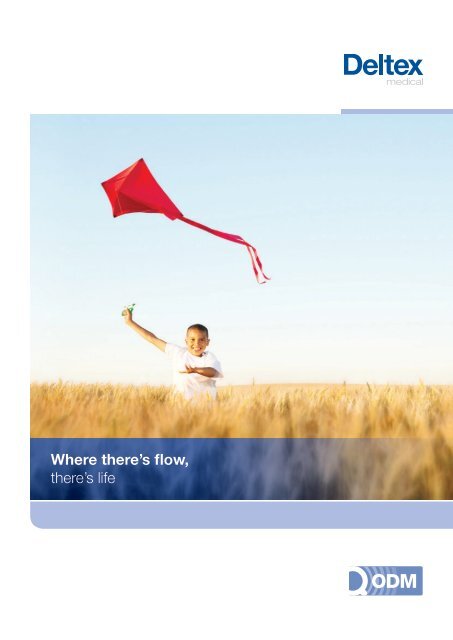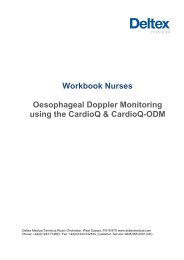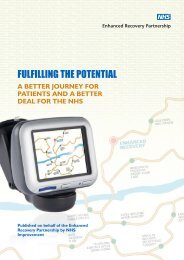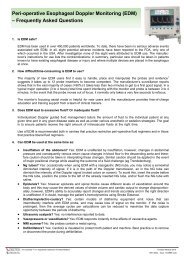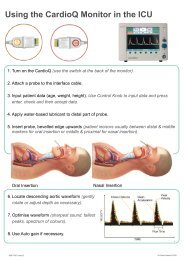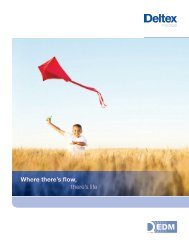New CardioQ–ODM Brochure - Deltex Medical
New CardioQ–ODM Brochure - Deltex Medical
New CardioQ–ODM Brochure - Deltex Medical
Create successful ePaper yourself
Turn your PDF publications into a flip-book with our unique Google optimized e-Paper software.
Where there’s flow,<br />
there’s life
think Doppler.<br />
We will launch a<br />
national drive to get full<br />
implementation of ODM, or similar<br />
fluid management monitoring<br />
technology, into practice<br />
across the NHS.<br />
Sir Ian Carruthers, OBE, (NHS Innovation,<br />
Health and Wealth Review 2011)<br />
High Impact Innovation<br />
The NHS Operating Framework 2012 and the NHS Innovation<br />
Health & Wealth Review 2011 named ODM as one of six<br />
high impact innovations and called for the widespread<br />
implementation of ODM for fluid management in surgery.<br />
The recently launched Intraoperative Fluid Management<br />
Technologies (IOFMT) Adoption Pack from the NHS National<br />
Technology Adoption Centre (NTAC) – commissioned by<br />
the Department of Health (DH) – simplifies and facilitates<br />
the implementation process. For more information,<br />
visit www.ntac.nhs.uk<br />
By complying with the implementation<br />
requirements for these high impact<br />
innovations by April 2013, NHS organisations<br />
pre-qualify for the CQUIN payment scheme,<br />
worth 2.5% of their revenue.<br />
In March 2012, NHS Supply Chain<br />
awarded <strong>Deltex</strong> <strong>Medical</strong> a two-year<br />
contract to supply the CardioQ-ODM<br />
to the NHS.<br />
Fluid Management Monitoring<br />
Technologies can reduce mortality<br />
rates for elective procedures, improve<br />
the quality of care for more than 800,000<br />
patients a year, and save the<br />
NHS at least £400m annually.<br />
Sir David Nicholson, Chief Executive of the NHS in England<br />
(NHS Innovation, Health and Wealth Review, 2011 - based on MTG3)
When fluid management really matters,<br />
Not all cardiac output<br />
devices are the same<br />
Widely proven and suitable for use across<br />
the surgical population, oesophageal Doppler<br />
monitoring (ODM) using the CardioQ-ODM, is<br />
the only minimally invasive therapy to measure<br />
blood flow directly in the central circulation.<br />
The clinical benefits of the CardioQ-ODM stem directly from<br />
the use of a low-frequency ultrasound signal to measure blood<br />
flow directly in the central circulation.<br />
Only Doppler works<br />
Only the CardioQ-ODM has the precision necessary to guide<br />
successfully a 10% Stroke Volume Optimisation (SVO) protocol.<br />
Its considerable evidence base is testimony to the unique ability<br />
of the CardioQ-ODM to recognise and monitor 10% changes in<br />
Stroke Volume.<br />
Other cardiac output devices do not have the required precision.<br />
Technologies using pressure or bioreactance as a surrogate<br />
for flow are confounded by changes in arterial compliance or<br />
impedance, regularly reporting changes in the wrong direction.<br />
As such, they are not appropriate to guide Stroke Volume<br />
Optimisation (SVO) without frequent, expensive, and time<br />
consuming recalibration by a more precise technology.<br />
Flow versus Pressure<br />
<br />
frequently.<br />
<br />
such change precisely; surrogates cannot.<br />
<br />
devices measure pressure not flow and are<br />
confounded by changes in resistance.<br />
<br />
The CardioQ-ODM waveform<br />
Stroke Distance<br />
(cm)<br />
Mean Acceleration<br />
(cm/sec 2 )<br />
Peak Velocity<br />
(cm/sec)<br />
Flow Time (msec)<br />
The Enhanced Recovery<br />
Partnership fully supports the<br />
use of intraoperative fluid management<br />
technology to deliver individualised<br />
goal-directed fluid therapy. This is<br />
recommended in the 2012-13 NHS<br />
Operating Framework, in the Innovation,<br />
Health and Wealth Review,<br />
and in NICE Guideline MTG3.<br />
FIGURE 1<br />
<br />
The green line indicates the velocity/time envelope that the monitor uses<br />
to make calculations. The white arrows indicate time and velocity values<br />
used for CardioQ-ODM calculations.<br />
The Stroke Distance (SD) is the area under the waveform and is the basic<br />
measured parameter upon which calculations of Stroke Volume (SV) and all<br />
other Cardiac Output (CO) and indexed measurements are made.<br />
Stroke Volume is the parameter of choice for fluid management protocols,<br />
however changes in Stroke Distance (SD) or Stroke Volume Index (SVI) can<br />
also be utilised.<br />
(Fulfilling the Potential: A Better Journey for Patients and a Better Deal<br />
for the NHS (2012), NHS Enhanced Recovery Partnership)
think Doppler.<br />
Only Doppler is recommended<br />
The evidence in support of individually guided fluid management<br />
during surgery is centred on the implementation of oesophageal<br />
Doppler monitoring (ODM), using the CardioQ-ODM. The device<br />
has established an incomparable evidence base that is today<br />
acknowledged and endorsed by the National Institute<br />
for Health and Clinical Excellence (NICE). The NHS has<br />
therefore decided to adopt ODM at pace and scale.<br />
In its 2011 medical technology guidance on the CardioQ-ODM<br />
(MTG3), NICE asserts that the technology should be considered<br />
for use in patients undergoing major or high-risk surgery or<br />
other surgical patients in whom a clinician would consider using<br />
invasive cardiovascular monitoring.<br />
Randomised, controlled trials using the CardioQ-ODM have<br />
demonstrated that early fluid management intervention will reduce<br />
post-operative complications, reduce intensive care admissions,<br />
and reduce the length of hospital stay.<br />
To date, more than 500,000 patients have benefited from the<br />
use of the CardioQ-ODM, and the NHS National Technology<br />
Adoption Centre (NTAC) audit of over 1300 patients reported<br />
the benefits of ODM implementation in three hospitals:<br />
stay was reduced by<br />
3½ days and CVC use was reduced by 23%.<br />
<br />
towards a reduction in readmission rates,<br />
re-operations and mortality.<br />
<br />
from randomised controlled trials and as such,<br />
the technology constitutes a cornerstone<br />
of Enhanced Recovery.<br />
Systemic Vascular Resistance dyn·s·cm −5<br />
2500 10<br />
2000<br />
1500<br />
1000<br />
500<br />
Vasoconstrictor<br />
Calibration<br />
0<br />
3<br />
10:51:36 10:52:19 10:53:02 10:53:46 10:54:29 10:55:12<br />
FIGURE 2<br />
Effect of a vasoconstrictor on flow-based and<br />
pressure-based cardiac output monitors<br />
Time<br />
A<br />
B<br />
C<br />
9<br />
8<br />
7<br />
6<br />
5<br />
4<br />
Cardiac Output l/min<br />
Unique insight<br />
The graph to the left<br />
(FIGURE 2) illustrates the<br />
effect of a vaso-active<br />
drug on Systemic Vascular<br />
Resistance (SVR).<br />
It demonstrates dramatically<br />
the difference between<br />
a flow-based technology<br />
(CardioQ-ODM) and a<br />
pressure- based (PPWA)<br />
approach.<br />
This is a real patient event in which a vaso-active drug was<br />
administered. Almost immediately after the drug is administered,<br />
the pressure-based system (B) records the increased SVR (A)<br />
as an increase in flow. However, the unique and direct flow<br />
measurement of the CardioQ-ODM (C) shows the true - and<br />
opposite – result. The increased SVR causes a small fall in flow<br />
as the heart pumps against the increased vascular resistance.<br />
PPWA devices using pressure as a surrogate for flow<br />
measurement lack the precision necessary to guide the SVO<br />
protocol and often indicate that flow has increased when in fact,<br />
the opposite has occurred. The unreliability of the PPWA approach<br />
is due to the frequent changes in arterial compliance during the<br />
operative period.<br />
A<br />
B<br />
C<br />
Systemic Vascular Resistance (SVR)<br />
Pressure-based cardiac output monitor<br />
CardioQ-ODM<br />
(Flow-based cardiac output monitor)
Direct flow measurement<br />
Placing a single-use probe in the oesophagus, the<br />
CardioQ-ODM monitor uses Doppler ultrasound<br />
technology to determine directly a patient’s central<br />
vascular blood flow and fluid status during the<br />
intraoperative period.<br />
Easy to use and quick to focus, the device<br />
generates a low-frequency ultrasound signal, which<br />
is highly sensitive to changes in flow and measures<br />
them immediately.<br />
A<br />
Transmit crystal<br />
B<br />
Receive crystal<br />
B<br />
A<br />
FIGURE 3<br />
A An oesophageal Doppler probe is inserted into the patient’s<br />
oesophagus, either nasally or orally.<br />
B The transmit and receive piezo electric crystals at the tip of the<br />
probe measure velocity of blood flow in the descending aorta.
References<br />
Mythen MG, Webb AR<br />
<br />
Arch Surg.<br />
<br />
Sinclair S, James S, Singer M<br />
<br />
<br />
BMJ.<br />
Gan TJ, Soppitt A, Maroof M, El-Maolim H, Robertson KM<br />
<br />
Anesthesiology<br />
Venn R, Steele A, Richardson P, Poloniecki J,<br />
Grounds M, <strong>New</strong>man P <br />
<br />
<br />
Br J Anaesth.<br />
Wakeling HG, McFall MR, Jenkins CS, Woods WGA, Miles WFA,<br />
Barclay GR, Fleming SC<br />
<br />
<br />
Br J Anaesth<br />
Noblett SE, Snowden CP, Shenton BK, Horgan AF<br />
<br />
<br />
British Journal of Surgery<br />
Senagore AJ, Emery T, Luchtefeld M, Kim D,<br />
Dujovny N, Hoedema R<br />
<br />
<br />
<br />
Dis Colon Rectum<br />
Pillai P, McEleavy I, Gaughan M, Snowden C, Nesbitt I, Durkan<br />
G, Johnson M, Cosgrove J, Thorpe A.<br />
<br />
<br />
J Urol. <br />
Challand C, Struthers R, Sneyd JR, Erasmus PD, Mellor N,<br />
Hosie KB, Minto G<br />
<br />
<br />
Br J Anaesth<br />
Figus A, Wade RG, Oakey S, Ramakrishnan VV<br />
<br />
Ann Plast Surg<br />
Innovation Health and Wealth:<br />
<br />
NHS: National Institute for Health and Clinical Excellence.<br />
<br />
<br />
NHS National Technology Adoption Centre (NTAC)<br />
<br />
<br />
Product Description<br />
CardioQ-ODM Monitor (Product Code: 9051-7103)<br />
For adult and paediatric use (down to 3kg with<br />
KDP72) in operating theatre and critical care.<br />
Managed care service and rental option available<br />
upon request.<br />
Surgical Probes<br />
DP6 Doppler Probe (Product Code: 9070-7001)<br />
6-hour oral/nasal Doppler probe for patients under<br />
anaesthesia or full sedation.<br />
DP12 Doppler Probe (Product Code: 9070-7003)<br />
12-hour oral/nasal Doppler probe for patients under<br />
anaesthesia or full sedation.<br />
I 2 S Doppler Probe (Product Code: 9090-7012)<br />
6-hour oral/nasal Doppler probe for anaesthetised,<br />
sedated and awake patients.<br />
I 2 P Doppler Probe (Product Code: 9090-7013)<br />
24-hour oral/nasal Doppler probe for anaesthetised,<br />
sedated and awake patients.<br />
Critical Care Probes<br />
I 2 C Doppler Probe (Product Code: 9090-7014)<br />
72-hour oral/nasal Doppler probe for anaesthetised,<br />
sedated and awake patients.<br />
DP240 Doppler Probe (Product Code: 9070-7005)<br />
10-day oral/nasal Doppler probe for patients under<br />
anaesthesia or full sedation.<br />
Paediatric Probes<br />
KDP72 Doppler Probe (Product Code: 9081-7001)<br />
72-hour paediatric oral Doppler probe 3kg and above.<br />
When fluid management really matters, think Doppler<br />
<strong>Deltex</strong> <strong>Medical</strong><br />
Terminus Road, Chichester, West Sussex PO19 8TX<br />
To order please contact:<br />
Customer Service: 0845 085 0001<br />
Email: uksales@deltexmedical.com<br />
For enquires please contact:<br />
General Enquiries: 01243 774 837<br />
Fax: 01243 532 534<br />
www.deltexmedical.com<br />
AKA 9051-5522 Issue 3


